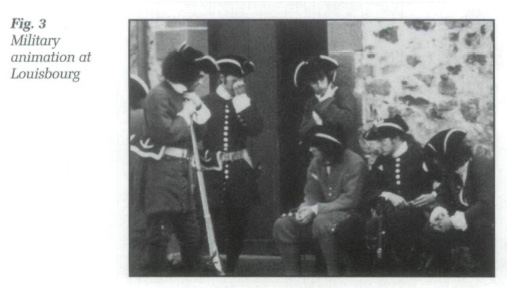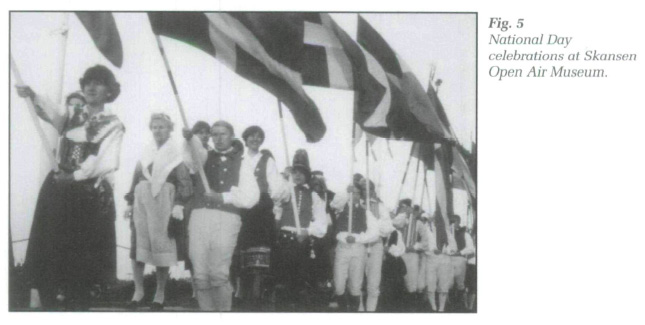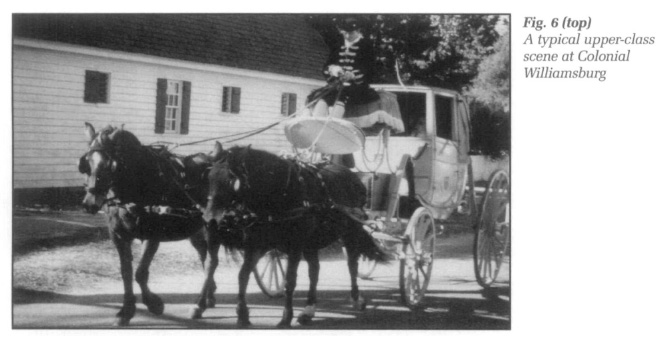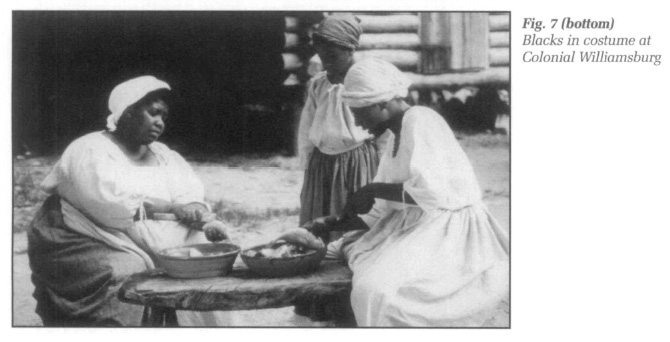Articles
The Making of Public History:
A Comparative Study of Skansen Open Air Museum, Sweden; Colonial Williamsburg, Virginia; and the Fortress of Louisbourg National Historic Site, Nova Scotia
Abstract
The public acceptance and popularity of outdoor museums and historic sites has increased in Europe and North America throughout this century. The Fortress of Louisbourg National Historic Site is Canada's most extensive attempt to reconstruct aspects of the past. It has served as a public history model for many exhibits and historic villages throughout North America since its inception in the 1960s.
The philosophies and methodologies of "making history" for the public have changed over the past century since the outdoor museum movement began in the 1870s at Skansen in Sweden. The Colonial Williamsburg Foundation led the process of historic site interpretation in the United States throughout the middle of the twentieth century, just as Parks Canada and the Fortress of Louisbourg set new standards over the past three decades.
This essay compares the three major projects as public history models for research and development and as reflections of the societies that created these particular versions of history for the public.
Résumé
Les musées extérieurs et les sites historiques ont été mieux acceptés du public et ont gagné en popularité en Europe et en Amérique du Nord au cours du XXe siècle. Le site historique national de la Forteresse de Louisbourg constitue la tentative la plus ambitieuse du Canada de reconstruire certains aspects du passé. Depuis sa création durant les années 1960, la Forteresse a servi de modèle d'histoire publique pour la conception de nombreuses expositions et la construction de villages historiques un peu partout en Amérique du Nord.
Les philosophies et les méthodes de vulgarisation historique ont évolué au cours du siècle depuis la création des premiers musées extérieurs à Skansen, en Suède, dans les années 1870. La Colonial Williamsburg Foundation a guidé le processus d'interprétation des sites historiques aux États-Unis jusqu'au milieu du XXe siècle, tout comme Parcs Canada et la Forteresse de Louisbourg établissent de nouvelles normes depuis trois décennies.
Dans cet article, l'auteur compare les trois principaux projets à titre de modèles historiques pour la recherche et le développement et de reflets des sociétés qui ont créé ces versions particulières de l'histoire pour le public.
1 In the internationally best-selling book Sarum: The Novel of England, Edward Rutherfurd wrote more than a thousand pages about the Salisbury Plain and Stonehenge, and what it has meant as a special place in English history. His method was to select accurate information in a personal way and hope that in doing so he "may have conveyed something of the wonder of the place."1 In Canada, the Fortress of Louisbourg National Historic Site, even with its more recent and relatively short history, has also become a very well documented and special place in Canadian history. In their work the historians, archaeologists, builders, curators and interpreters have selected information and presented their version of the history of Louisbourg to the public in the form of a physical and visual reconstruction, supplemented by text and illustrations. That was their method and the general public was their audience, just as literature and the general reader guided Rutherfurd's attempt to represent Sarum.
2 Historical art and fiction, history museums and historic sites, historical restorations and reconstructions, art galleries and even theme parks have made an important contribution in Europe and North America to the public consumption and understanding of aspects of the past, though they often distort it. The Canadian experience is recent and isolated, largely because of French and British colonial status and regional contrasts in geography and political culture. Canadian artists and writers of historical fiction and scholarship began to flourish after the Second World War, and the museum and heritage preservation movement gradually began to take shape after 1950. That progress in what has been termed "public history" reached its apogee in the 1960s, in the years preceding and following Canadian centennial celebrations in 1967, including the world's fair in Montreal, Quebec. Research and development at Louisbourg, spanning the years 1961 to 1981, constituted by far the largest undertaking in the Canadian heritage field at that time and was one of the largest of its kind in the Western world.2
Louisbourg Historiography and Early Museology
3 Because of its brief, compact and well-documented history, Louisbourg has provided the basis for fascinating and varied studies of eighteenth-century French culture transplanted to North America. Unlike all other substantial and significant colonial sites, Louisbourg has no major continuum into the nineteenth and twentieth centuries, no city built over it. The result in historical, archaeological and museological terms has been a unique and extraordinary opportunity to preserve, study and describe the material culture and life of an important eighteenth-century North American community.
4 Two hundred years elapsed between abandonment of Louisbourg by the French and British and major development of its remains as a Canadian historic site, but its historical significance was recognized throughout the intervening period. The ruins were visited and written about continuously by small numbers of informed visitors, and there is an extensive historiography on Louisbourg in scholarship and fiction throughout the nineteenth and early twentieth century.
5 Although Louisbourg was widely appreciated for its historical significance, the principal impetus for major site development was socioeconomic, not historical or cultural. Any attempt to understand the scope and the pace of the reconstruction project must begin with that premise. The essential problem confronted in 1959 by local and federal government officials was the serious decline of the coal and steel industries in a local economy that lacked diversity. Widespread Canadian de-industrialization meant that displaced workers could not be absorbed elsewhere in the region. By the 1950s, Canada had developed a strong tradition of government intervention in the economy. In 1950 the Royal Commission on National Development in the Arts, Letters and Sciences (Massey Commission) began the expansion of the federal government's role in the cultural and intellectual life of Canadians.3 The gradual growth of this trend in subsequent decades provided the social and political climate in Ottawa that made possible the decision to provide federal government funds for major development of the Louisbourg ruins as a Historic Site.
6 The Massey Commission in 1950, and government action on many of its recommendations, principally the creation of the Canada Council and increased financial support for universities, museums, art galleries and for the performing arts, marked the end of slow growth in Canadian museums and cultural institutions. As Canada matured as a nation with strong British and French traditions to counterbalance the increasing and controversial influence of American values and culture, the importance of government action as an agency of change and growth was recognized. Modern Canadian museums, and heritage and cultural agencies, developed mainly as public institutions on both the national and provincial level. The national museums were concentrated in Ottawa until the new Canadian Museum of Civilization was constructed across the Ottawa River in Hull, Quebec. Provincial museums and agencies developed in all provinces and, within Parks Canada's system, national parks and national historic sites were established in every region of Canada.
7 Although the principal impetus for Parks Canada's Louisbourg project in 1960 was socioeconomic and local, the cultural importance of the Fortress of Louisbourg after 1960 soon increased to national proportions. The Rand Royal Commission recommended in August 1960 that "beginning not later than in the year 1961, work on a scheme of reconstructing the ruins of the Fortress of Louisbourg as an historic site be commenced..."4 In accepting the recommendation, the federal cabinet of Canada phrased its decision in a manner equally as pertinent to the project's philosophy and objectives:
8 By the early 1980s the Louisbourg project, its ruins and partial reconstruction, had become one of the largest historic sites and outdoor museums in the Western world , highly acclaimed within the Canadian museums community because of its high research standards and related accuracy of reconstruction. This paper will compare Louisbourg to the Skansen Open Air Museum in Stockholm, Sweden, and to the Colonial Williamsburg complex near Richmond, Virginia, in the United States. Both are similar in scale and in sophistication to the Louisbourg project. I have visited both for extensive study and there has been sufficient published literature on each to investigate their historical, archaeological and museological development. The literature has revealed that all three projects experimented with new methods throughout their research and development, and that they were not content to limit programming to established and traditional museological norms.
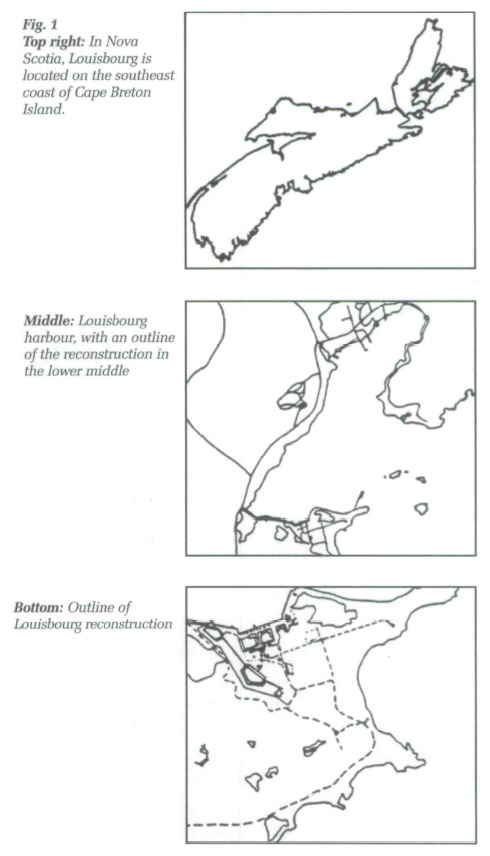 Display large image of Figure 1
Display large image of Figure 1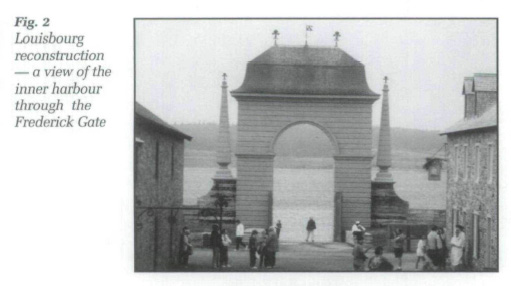 Display large image of Figure 2
Display large image of Figure 29 The three institutions also mark key periods of "making history" for the public — they are the products of certain ideological and economic factors. As major projects with high profiles in the museum community and in the public eye, they also became embodiments of key stages of museological and cultural resource development. Skansen, Williamsburg and Louisbourg also contributed to the growth of international cultural tourism in all three countries.
Skansen Open Air Museum
10 Most published literature on the origins and development of outdoor museums begins with a description of Skansen Open Air Museum, Stockholm, in the 1870s, and a sketch of the career of its founder, Arthur Hazelius, a brilliant Swedish educator as well as a linguist, folklorist, and oral history pioneer. As a devotee of Sweden's national heritage as expressed in nature and in the works of its many cultures, he studied all classes of urban and rural society, not just the new urban elite. His natural and cultural resources at Skansen included examples of Sweden's distinct flora and fauna, vernacular architecture, material culture, and its thriving and diverse performing arts. Hazelius was a tireless field worker who was as comfortable in the remote farm villages of Sweden as he was in the meeting rooms of powerful politicians, academics and professional groups in Stockholm, and the Skansen collections reflected his work.
11 At Skansen he began to assemble representative buildings, in some cases entire farms along with the animals and the rural folk who ran the enterprises, in an outdoor museum overlooking the commercial and institutional centre of the city. On a rolling hillside site he relocated, constructed or reconstructed an eclectic, curious and comprehensive blend of educational and recreational resources that would eventually comprise 150 buildings within a 75-acre area. Included were an extensive craft complex, a park containing his own version of a botanical garden, zoological gardens and a children's zoo, as well as period and modern restaurants and a tavern. An extensive outdoor performing arts centre was built near a strategically located viewing station on an elevation overlooking the city of Stockholm and its beautiful archipelago. This unconventional mix of outdoor museum collections was popular from its inception and still attracts more than two million people annually, many of them repeat visitors from the Stockholm area who cherish Skansen Open Air Museum as a refuge from the usual vicissitudes of a large city. This is largely because Skansen occupies a very specific phase in the idea of being Swedish, serving as a focal point for a renewed national consciousness.
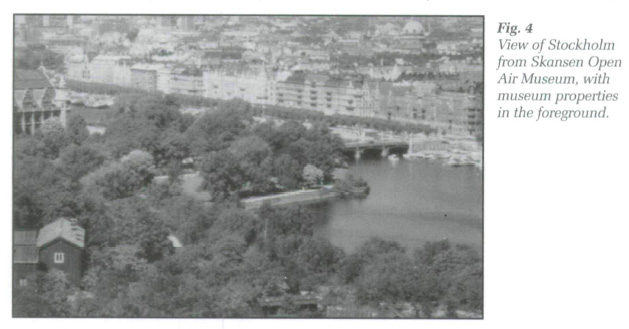 Display large image of Figure 4
Display large image of Figure 412 However Skansen is denned, it is a uniquely Swedish reflection of folklife through several centuries. It is impossible to discern a sequential or chronological storyline or topical summary in its many properties and exhibits, but somehow a reasonably coherent impression of history is conveyed. There is no question that the Skansen complex is confusing on first encounter, as are most large museum operations that are introspective of one culture, particularly to visitors from a different culture. There is a peculiar educational advantage in Skansen's diversity, however, one that Louisbourg also enjoys: the visual and psychological contrast with almost everything that surrounds it. The official Skansen guidebook described the complex as: "....a green, car-free oasis in the middle of the city. There are magnificent views in every direction." Skansen was officially opened to the public in 1891, as an innovation that would inspire the museum world and folklife studies in Europe and North America for the next century:
13 Museum resources at Skansen and the manner in which they are presented to visitors reveal a research and development program that has concentrated on the ordinary folk of Sweden, their costume and daily working life, their properties and their music and dance entertainment. This has allowed Skansen to serve as more than a museum, as a folklife educational project and an international cultural tourism centre. As an outdoor museum with buildings gathered from many different areas of Sweden, however, it lacks the in situ authenticity of the Louisbourg ruins and reconstruction. Skansen, nevertheless, is comparable as a cultural landscape and at least as stimulating as a public history model.
14 Most published literature on Skansen and the work of Hazelius acknowledges the site as a major museological and educational innovation, and consistently praises its founder as a genius in the field. The principal museum research and development phase occurred in the late nineteenth century, when few museums in Europe had anything to display or to say about the common folk. As traditional and largely conservative institutions, most large European museums perpetuated the social control of the ruling elites, reflecting their power and their exclusive privilege to select and display their own version of history, material culture and art. A more progressive social history and the public history interpretation of the lower classes at the Louisbourg project were part of a general movement in the 1960s and 1970s, but at Skansen in the 1870s such work represented a radical departure from established museological norms, just as Sweden and its society at that time contrasted with the other countries of western Europe and North America near the end of the industrial revolution.
15 Only Scandinavia emulated the Hazelius model in any way in the early part of this century. The rest of Europe and North America, including Canada, would wait many decades before devoting significant public museum resources to the history of the common folk. Hazelius and the Skansen staff challenged prevailing notions of just whose history warranted study and national support, and in this the Stockholm creations eventually provided an inspiring starting point for folklife studies, historic site development and outdoor museum presentations throughout Europe and North America, including at Louisbourg. The Louisbourg project and Parks Canada in general, even with its manifold resources and national political mandate, could not completely follow the Skansen model. Public education falls within the stated objectives of Parks Canada, albeit as secondary to in situ preservation. You cannot see a beautiful city such as Stockholm from these remote sites, but you can see the Atlantic Ocean and a rugged coastline. Much more can be done at Louisbourg to combine the study of original and reconstructed cultural resources with natural history.
16 One of the aims of this essay is to compare Skansen and Louisbourg on the basis of their different methods of preserving and of interpreting historical properties. Once again the distinction has to be made that the Louisbourg reconstruction has been developed on its original site, whereas Skansen has assembled buildings from various districts in Sweden. Skansen has been criticized in the heritage community "as a threat to older buildings that still stand where they were originally erected;"7 just as the Louisbourg reconstruction has been criticized in the Canadian museum and preservation community as a drain on funds that could have been spent on deteriorating original buildings that could be restored, not moved or reconstructed. The two museum projects, however, are more than justified for the wider appreciation they engender in the public mind for the preservation and study of cultural and natural heritage.
17 With more time, sustained effort and sufficient resources, Louisbourg could become the cultural, economic and educational stimulus to Canada that Skansen has become for Sweden. Despite the disadvantage of being at such a distance from major cities and from the institutions that have coalesced around urban centres in the early decades of the information age, the Louisbourg site and Cape Breton cultural tourism in general have high potential for educational and cultural programming in the global village of the information age.
Colonial Williamsburg
18 Inevitably when Louisbourg has been discussed at history museum meetings or conferences and in the many publications on its reconstruction and interpretation programs, parallels with Colonial Williamsburg, Virginia, are made. Research and development has been continuous at Williamsburg since 1926, and the first major restored property was open to the public in 1932. By 1980 the amalgam of restored and reconstructed properties comprised approximately 150 structures, making it one of the largest outdoor museums in the world. Its history as a colonial capital also parallels Louisbourg, though the two sieges at Louisbourg and its busy harbour and waterfront — and the obvious differences in the two cultures and mercantile economies of England and France — give the two communities very distinct histories. The social composition of the two communities also differed, for example with the much higher proportion of slaves in Virginia and itinerant European fishermen in Isle Royale. Nevertheless, there is much in terms of their history and their research and development as museum projects that the two locations share.
19 The context for the development of Colonial Williamsburg over six decades is in contrast to Louisbourg, and the Williamsburg source of operating funds also differs. Louisbourg has been a publicly funded project throughout research and development and during its operation as a National Historic Site, whereas the initial research and development phase at Colonial Williamsburg was financed primarily by substantial endowments from the wealthy industrialist, John D. Rockefeller Jr. After completion of the initial phase at Williamsburg, major additional funding was derived from admission fees and from extensive retail sales outlets, all of which were expected to defray operating costs. This was a deliberate policy that followed the tradition of the origins and development of United States museums, which were founded on individual enterprise and private capital, with government support only as a secondary factor.
20 Unlike the Louisbourg site, Williamsburg was left with extensive above-ground structures that were never entirely abandoned, and its archaeological resources and research capability were at least equal to that of the Louisbourg project. As an important eighteenth-century colonial capital, Williamsburg also benefited from a rich and comprehensive database of documentary evidence, and iconography, but unlike the Louisbourg project, the research staff did not have to comb through England and France to locate and copy it. Curatorial collections were also readily available and in many more instances were drawn from their original eighteenth-century context, whereas Louisbourg had to acquire its generally representative collections on the European and North American antique and art collectors' market. Despite these significant differences, the two projects are remarkably similar in archaeological and architectural achievements, and especially in some aspects of their interpretation to the public, principally the period presentation of domestic architecture in complete property settings validated by archaeological evidence and enhanced by costumed interpreters.
21 Williamsburg, because of its geographical location, its stronger place in the nation's history and national consciousness, its longer and richer history of research and development and its vigorous promotion internationally, has enjoyed a much higher visitation by the public. This has produced concomitantly higher admission and sales revenue and many more academic and popular publications on its history, archaeology and museology. The project has also received more criticism than Louisbourg, especially for its early interpretation programming. There is no doubt that Colonial Williamsburg has from the outset fashioned history to celebrate American independence, patriotism and capitalism in full measure as a national icon, cultural resource and international tourism commodity. There is also no question that Williamsburg public history has until very recently concentrated only on the elite of colonial society, to the deliberate and conspicuous exclusion of blacks and the poor, children and family life and women in other than subordinate social roles; the entire historical experience of women and the common folk have been ignored in favor of the ruling political and economic elite.
22 Colonial Williamsburg's many and highly selective commercial presentations to the general American public could not survive the social revolution and accompanying civil rights awareness of the 1960s, just as French institutions were threatened and transformed by the 1789 Revolution. As a popular national attraction near the centre of the former American south, where slavery had been prominent, Williamsburg began to experience controversy as a national monument to capitalist exploitation. More recent and stinging criticisms of the Williamsburg project have been led by Michael Wallace, a New Left historian with an alternative perspective on American social and economic history. In an article on American history museums in 1981 he wrote about Williamsburg and its founder:
23 Wallace may well have leveled that criticism at the majority of established museums, which by their very nature reflect in general terms the culture and society that created and sustains them. It was Williamsburg's deliberate and enduring detachment from historical reality that finally provoked major changes. Later in the same article Wallace invoked two other well-established commentators on social history and museums to make an important and convincing case for a more balanced historical interpretation, with Williamsburg again cited as the antithesis of historical reality. He quotes Ada Louise Huxtable as saying that Colonial Williamsburg "pickled the past," that it lacked "any sense of reality, vitality or historic continuity." Wallace then referred to a more general comment by David Lowenthall:
Wallace quotes another leading American museologist and senior Williamsburg executive, Edward P. Alexander, on the need for revision, that museums had been:
24 All of this criticism eventually led to progressive changes at Colonial Williamsburg, including the acknowledgement and public history interpretation of black history in the colonial capital.
25 Louisbourg historiography and museology, developed since 1960 with the benefit of the earlier Skansen and Williamsburg experiences, has not followed the American pattern of social history elitism and exclusion. This difference has been most evident in Louisbourg's interpretation programs, which have focussed on the lower classes of society and on the majority of the French colonial population. This emphasis has been less evident in the physical reconstruction of buildings, where Louisbourg, like Williamsburg, developed a preponderance of substantial public buildings and military features within its historic boundaries.
26 Williamsburg, as with Louisbourg, is not overwhelmed by modern exhibits. One of the best exhibits in place in the early 1980s, and one similar in many respects to a Louisbourg exhibit on how the reconstruction developed, concerns archaeology and how it validated property restorations, reconstructions and curatorial programs. Artifacts were displayed with concise labels and very few graphics. Audio narration, a separate slide show and a diorama on excavation techniques were complemented visually by an exposed excavation on the inside of an adjoining outbuilding. This combination of media very effectively explains to the general public the intricacies as well as the fascinating discoveries involved in archaeological work. As at Louisbourg, such exhibits are essential for visitors to understand with the aid of familiar and modern educational methods the complex of eighteenth-century architecture, material culture and costumed activity that surrounds them in abundance at both sites.
27 As indicated earlier, there is a fundamental difference in the funding base of heritage institutions in the United States, which receive relatively low levels of public funding or grants, and Canada or Sweden, where most large institutions and the majority of smaller museums are financed primarily by government funds. The impact on public history programming can be profound in ideological as well as museological terms. There is no doubt that Williamsburg has produced a sanitized version of Virginia's history and a biased celebration of American patriotism and capitalism. This highly selective historical interpretation has been criticized by museologists and academic historians as a product of upper- and middle-class privilege and exclusion.
28 In a different but equally biased way the Louisbourg project has often attempted to romanticize the interplay of native, French and British cultures, usually to serve national policy on bilingualism and multiculturalism. There was nothing harmonious about France and Britain in Europe and North America throughout the eighteenth century, and the native population was always caught in the middle of this constant warfare and commercial rivalry. At Williamsburg and Louisbourg the public deserves balanced historical truth, and eventually they will develop their own version of reality. Despite these ideologically driven efforts, which were a product of their time and which engendered serious academic criticisms, the Williamsburg and Louisbourg projects have been a major and progressive influence in the fields of historic site preservation, museum development and public history, just as Skansen had been in earlier decades.
29 The Louisbourg project began to experiment with education and interpretation methods after 1970 and drew heavily from the Williamsburg experiences, good and bad, in an attempt to develop an accurate and realistic portrayal of the natural and cultural landscape as revealed in the historical and archaeological record. The transition from military and social history to effective interpretation of the fortress and town to the public was a new challenge, and 50 years of research and development at Williamsburg proved to be of inestimable value in this important and extensive work. Obviously, the historic sites, archives, libraries and museums of France were also essential in such a major effort to reconstruct a French fortress and town on the Atlantic coast of North America.
30 Paris was the starting point for research, especially the Archives Nationales, the Archives de la Marine and the Bibliothèque Nationale. There are many examples of institutional co-operation that have influenced the reconstruction, display and interpretation of in situ French features at Louisbourg, but one prototypical gallery exhibit has made a major museological contribution to the Fortress of Louisbourg National Historic Site and to Parks Canada in general.
31 The Musée de la Marine in Paris contains a collection of some of the Joseph Vernet paintings of port scenes in France. These were copied very early in the Louisbourg research program because of the close contact between the French colony of Isle Royale and the Ministry of the Marine, as well as the naval and commercial ties with La Rochelle, Rochefort, Toulon, Saint-Jean-de-Luz, Bayonne and Marseilles. Reproductions of the Vernet paintings have been used extensively in Louisbourg exhibits and in studies of its French architecture and material culture. When Parks Canada faced the challenge of interpreting the material history of the eighteenth-century Louisbourg waterfront and harbour to the public, a complete in situ presentation was impossible. Inspired by the Vernet port scenes, the Louisbourg project commissioned one of Canada's foremost historical illustrators, artist Lewis Parker, to depict the harbour and quayside in two large murals, which are on display in the reconstructed residence of the commissaire-ordonnateur, François Bigot. This gallery exhibition complements the reconstruction and has become a central component of Louisbourg's material and visual history.
Public History
32 In North America in general, particularly at Williamsburg in the United States, and at Louisbourg in Canada, there has been an exceptional effort to present history to the public in a more full historical and cultural context as an amalgam of European, native and African traditions, with guides and costumed staff providing an active interpretation of both the natural and cultural environment. The Louisbourg reconstruction has often been the point of comparison for new historic site and outdoor museum projects. The overwhelmingly positive public response to such projects and the economic benefits to the tourism economy are often the principal justifications used as the basis for significant resource allocations by governments. The cumulative effect has been a more vigorous pursuit of public history, providing yet more examples of how different cultures present their history in different ways.
33 Public history is better served and experienced when all classes of society are studied and when the monuments, records and material culture of ordinary folk are presented with the same enthusiasm as those of the rich and famous. Outdoor museums in Europe and North America are products of this past century and in their presentations they have provided a balance to the more elitist institutions and bourgeois historiography that have been derived from earlier societies. Bourgeois historiography and archaeology produce bourgeois museology, and the museum legacies of this tradition blanket the urban landscapes of older cities in both Europe and North America. In its historical research program and in its development as a historic site and outdoor museum, Louisbourg has taken special efforts not to perpetuate this tradition. This open philosophy and inclusive policy evolved because the Louisbourg project developed during a period when most Canadian museums and cultural agencies enjoyed and actively sought general public support and participation.
34 Museums in Canada became accessible educational resources and a component of nation building after the public success of centennial celebrations. In 1977 a former Director of the Nova Scotia Museum and President of the Canadian Museums Association, Donald K. Crowdis, commented on this modern trend:
35 Why does the modern Canadian public continue to visit and support museum collections in increasing numbers? The answers to these questions can provide a foundation for a better understanding of the public history phenomenon, its central importance in society and how it can be pursued more successfully. Many of the answers are rooted in the basic reasons why people collect. Susan Pearce, a British museologist, wrote that souvenirs make public events private, and that they move history into the personal sphere, giving each person a purchase on what would otherwise be impersonal and bewildering experiences:
36 Pearce has articulated the compelling link between history and the public, founded on the fundamental need within people to situate themselves in an often confusing world. This need to seek a personal and public history through souvenirs, historic sites and museum collections has been intensified in the post-industrial age, with its dislocations and seemingly discontinuous change. We seem to need history more than ever.
37 Museums, particularly outdoor museums directly associated with historic people, places and events, communicate in a much more comprehensive and meaningful language than that of academic or conventional historiography with its limited text and illustration, which helps to explain the more popular appeal of historic sites, museums and their collections. This process of investigating meanings does not end with curators, museologists and historians, not even with museum educators and public historians, for the museum visitors — the public consumers of history — invest their own personal history, as they see fit, to derive impressions, emotions and intellectual understanding. It could be argued that every visit to a museum or historic site or, for that matter, every reading of a history text or viewing of a display or interpretation activity produces a very different set of experiences, perspectives and conclusions. This "invested meaning" can be altered by the nature of the museum or historic site experience, of course, but it is always a factor in the learning process, just as reading a book for the second time can produce different insights because we bring a different knowledge base to our comprehension of the original.
38 In a book of essays, The New Museology, Ludmilla Jordanova, a historian at the University of Essex, offers an important commentary on the Jorvick Viking Centre in York, England, that could be applied to the Louisbourg project and to many other outdoor museums that have followed the living history model. Jordanova moves beyond material analysis and visual impressions to the contemplation of more abstract human experiences:
39 The outdoor museum and public history educational process involve ideas as well as collections; learning through sensory observation, reflection and thought. This non-academic, nevertheless serious pursuit of history was intended to be both a physical and mental involvement by the visiting public. In another recent book about the social and intellectual meanings of sightseeing and tourism in Europe, Australian political scientist and historian Donald Home wrote in 1984:
40 The pursuit of personal and public history has become more important in the modern age, as a relief for the mind and emotions and, of course, as a leisure and travel activity. This trend, along with the democratization and popularization of many museums and cultural centres, their collections and their stories, encourages a more active involvement on the part of the museum staff and, more importantly, the visiting public. Louisbourg, Skansen, and Williamsburg have attempted to present in an active way a comprehensive cross-section of past cultures to the general public, employing an equally comprehensive range of education and interpretation methods. The validity of these museums is rooted in popular culture; they inform a larger public and collectively they combat the social isolation of the more elitist and exclusive forms of cultural heritage. Their validity is also rooted in both academic and popular history and in consistently high standards for research and development, characteristics that have endured at the Louisbourg project since 1961 and that have brought Louisbourg's history beyond academic scholarship and bourgeois museology to a more full appreciation by the general public.
Louisbourg and Public History
41 When Canadian historian Christopher Moore wrote those words in 1982 the Louisbourg reconstruction project was near completion and was already receiving national acclaim from authors such as Moore, who had developed his approach to popular history as a staff historian at the Louisbourg project. His views were shared by ever-increasing numbers of the general public who had developed a new sense of history from visits to the site, from reading about it and from thinking about its special relevance in their own lives. For more than two decades Louisbourg had developed as a mirror of Canadian heritage, reflecting French, English, native and American traditions. It has also served as a testimony to the growth and maturity of the heritage preservation movement in Canada and to the vicissitudes of the Cape Breton economy.
42 The success of Skansen was based largely on the educational genius and organizational talent of its founder, Artur Hazelius, who was determined to understand the history of the ordinary folk of Sweden and to explain this to the public at Skansen and beyond: in the school system, the museum community, the university, via the performing arts and in popular culture. His original concept of education and extension, his dedication and that of his adherents at Skansen and elsewhere, have won both national and international acclaim since 1873. Its national appeal, as well as its international significance, has developed because it was created at a moment of extraordinary political and social change in Sweden and because the project met the spirit of the times.
43 Louisbourg also challenges its visitors and those who study it through other media to view Cape Breton and Canada, today and in history, in a different way. Its combination of natural and historical resources and its blend of cultural traditions impart a special public history educational opportunity; one of clear contrast with its surroundings, much as Skansen and Williamsburg have induced in many millions of visitors. Throughout the research and development phase of the Louisbourg project and in its first decades of operation as an outdoor museum and historic site, Parks Canada has continued to place primary emphasis on historical preservation and related interpretation, on the refinement of Louisbourg as a public history and educational product. As a large national agency with a primary in situ preservation mandate and secondary museological and educational role — now within the new Department of Canadian Heritage, which also administers cultural programs and all of the national museums — Parks Canada is certain to continue its focus on the cultural and heritage values of the Louisbourg reconstruction, consolidating and extending its role in public history and education.
